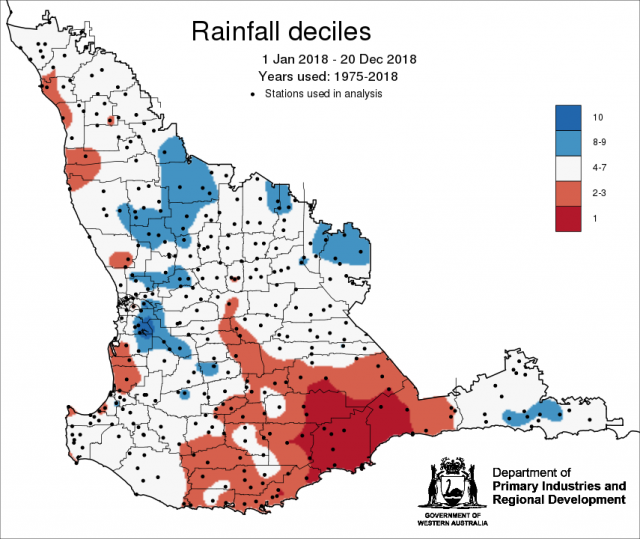Summary
The Department of Primary Industries and Regional Development’s (DPIRD) Statistical Seasonal Forecast (SSF) system for January to February 2019 is indicating mixed chances of exceeding median rainfall for the South West Land Division (SWLD). Due to the current US Government shutdown, data sets from NOOA (necessary for the calculated of the SSF) cannot be accessed, therefore the SSF is unable to be updated to include a March forecast.
- For January to February 2019, the SSF is indicating for above 60% chance of exceeding median rainfall for the far northern grainbelt, below 40% chance of exceeding median rainfall for south-eastern and Esperance shires and neutral chance elsewhere. The most probable decile range is decile 4-7 for most of the grainbelt and decile 8-9 for far northern grainbelt and Albany. Predictive skill based on November conditions is mostly poor to good (50- 70% consistent).
- The Bureau of Meteorology’s current seasonal outlook is indicating less than 40% chance of exceeding median rainfall for January to March 2019 for the SWLD. Predictive skill is poor to moderate (45-65% consistent).
- Temperature outlooks for January to March 2019 from the Bureau indicate 50-75% chance of above average day-time maxima for the SWLD. Skill is moderate to good at 55-75% consistent. Minimum temperature outlooks indicate 30-60% chance of above average night-time minima (lower chances along the coast), with skill mostly moderate at 50-65% consistent.
- December rainfall was generally average in the SWLD. December maximum temperatures were average to above average and minimum temperatures were average.
- It is important to note that historically, SWLD January and February rainfall is usually very low. However, localised and quick forming thunderstorms can bring heavy rainfall and statistical and dynamical climate forecasts can miss these weather systems.
Three month outlook for the south-west of Western Australia
Statistical Seasonal Forecasting (SSF)
DPIRD’s SSF system uses historical relationships between global sea surface temperature and sea level pressure with rainfall in south-west Australia to produce forecasts of rainfall for the coming months. Users can click on any station indicated on the map for location-specific forecast information from the Seasonal Climate Information page. Currently there is no climate data coming from NOAA and the SSF can’t be updated.
For January to February 2019, the SSF is indicating for above 60% chance of exceeding median rainfall for the far northern grainbelt, below 40% chance for south-eastern and Esperance shires and neutral chance elsewhere. The most probable decile range is decile 4-7 for most of the grainbelt and decile 8-9 for far northern grainbelt and Albany. Predictive skill based on November conditions is mostly poor to good (50-70% consistent).
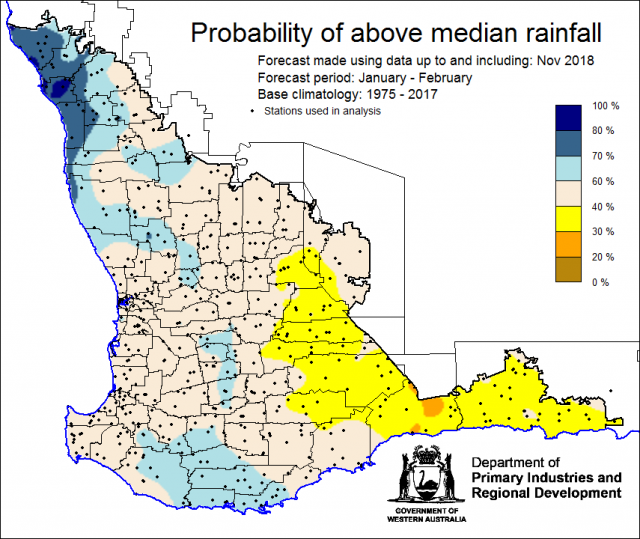
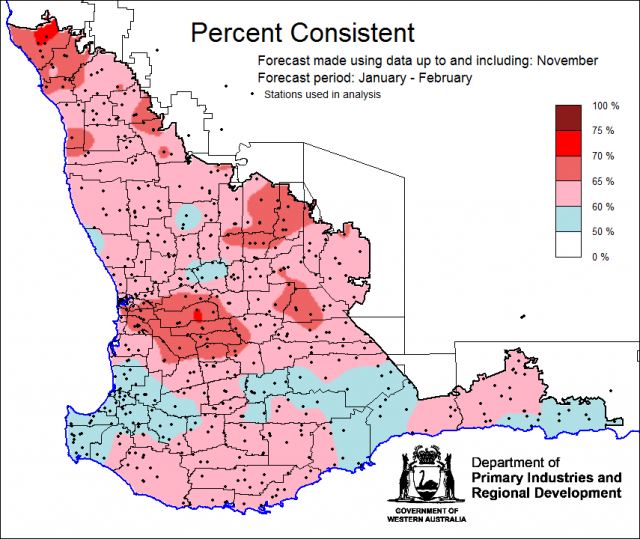
Bureau of Meteorology seasonal climate outlook
The Bureau of Meteorology's climate forecast system for monthly and seasonal climate outlooks is called the Australian Community Climate Earth-System Simulator – Seasonal (ACCESS–S). It is a dynamical (physics-based) forecast modelling system and is a collaboration between the Bureau of Meteorology and the UK Meteorological Office.
The Bureau of Meteorology’s current seasonal outlook is indicating a less than 40% chance of exceeding median rainfall for January to March 2019 for the SWLD. Predictive skill is moderate to good (55-75% consistent).
Temperature outlooks January to March 2019 from the Bureau indicate 50-75% chance of above average day-time maxima for the SWLD. Skill is moderate to good at 55-75% consistent. Minimum temperature outlooks indicate 30-60% chance of above average night-time minima (lower chances along the coast) , with skill mostly moderate at 50-65% consistent.
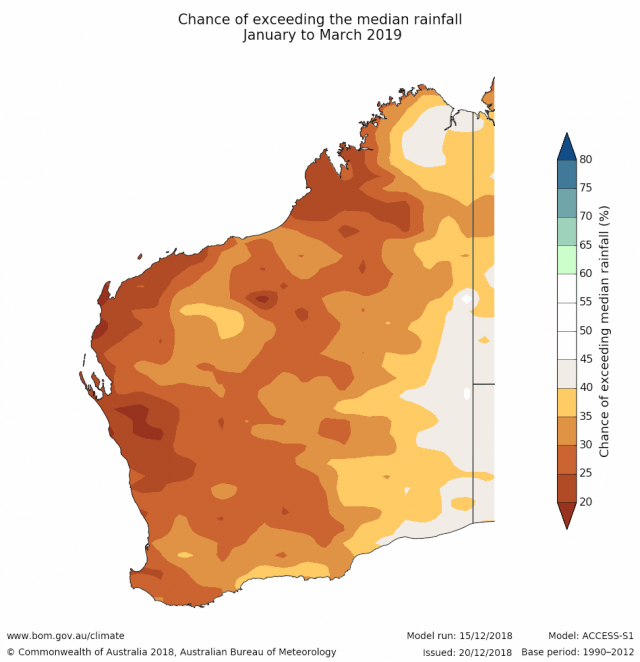
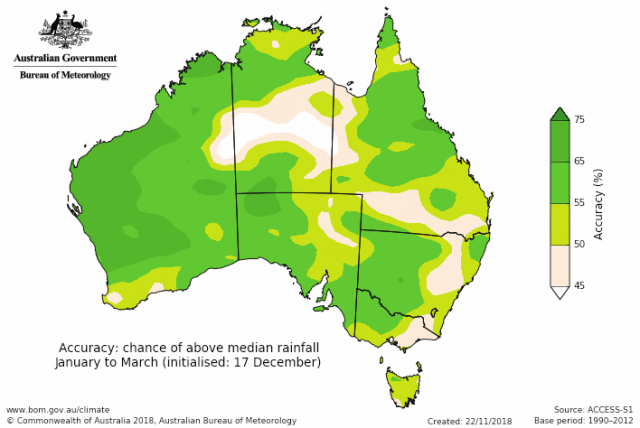
Recent climate
December rainfall was generally average in the SWLD. December maximum temperatures were average to above average and minimum temperatures were average.
For 2018, January to December rainfall was decile 1 for the Jerramungup shire and parts of Gnowangerup, Kent and Ravensthorpe shires. Decile 2-3 rainfall for many shires in the Great Southern, average rainfall (decile 4-7) for the majority of the grainbelt and decile 8-9 rainfall for parts of Dalwallinu, Wongan Hills–Ballidu, Perenjori, Moora, Victoria Plains, Mount Marshall and Yilgarn shires.
It is important to note that historically, rainfall is very low for the months of January to February. However, localised and quick forming thunderstorms can bring heavy rainfall and statistical and dynamical climate forecasts can miss these weather systems.
In December, the atmospheric pressure was near normal over most of Australia. The Indian Ocean sea surface temperatures off the western WA coastline are expected to remain cooler than average, reducing the amount of moisture evaporated off the eastern Indian Ocean, and therefore likely limiting moisture flowing into WA.
The Southern Annular Mode (SAM), also known as the Antarctic Oscillation (AAO), describes the north–south movement of the westerly wind belt that circles Antarctica, dominating the middle to higher latitudes of the southern hemisphere. SAM is currently positive. In a positive SAM event, the belt of strong westerly winds contracts towards Antarctica, resulting in weaker than normal westerly winds and higher pressures over southern Australia, restricting the penetration of cold fronts inland. The National Oceanic and Atmospheric Administration (NOAA) suggests that SAM is likely to remain positive until mid-January.
The positive Indian Ocean Dipole (IOD) event has ended, and neutral IOD conditions prevail. The IOD typically has little influence on Australian climate from December to April. The IOD typically has little influence on Australian climate from December to April. See the Bureau of Meteorology’s IOD and Pacific Ocean interaction for details.
While tropical Pacific Ocean waters have warmed above El Niño levels, the atmospheric component of the El Niño–Southern Oscillation (ENSO) has not responded, meaning an El Niño event is yet to become established. Outlooks suggest waters are likely to remain at El Niño levels through the coming months, which will increase the chance of the atmosphere responding, particularly later in the season.
The table below gives a summary of past month and three month south-west Western Australia (SWWA) climate conditions, and can indicate what is likely to occur in the near future if climate conditions follow the current pattern.
| Climate indicator | Past month | Past three months |
|---|---|---|
| SWWA rainfall | Generally average | Generally average |
| SWWA mean temperature | Average to above | Average to above |
| SWWA atmospheric pressure | Near normal | Near normal |
| Indian Ocean sea surface temperature | Cooler | Cooler |
| El Niño/Southern Oscillation (ENSO) | Neutral | Neutral |
| Indian Ocean Dipole (IOD) | Neutral | Positive |
| Southern Annular Mode (SAM) | Positive | Positive |

